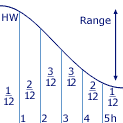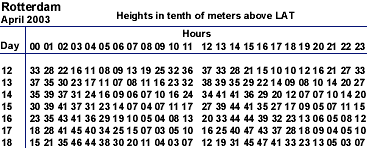Coastal
NAVIGATION
Tide prediction
1 - Information from the chart
Most often the chart presents succinct tide tables for certain positions
 |
We shall use this table to solve two types of problems. Finding height of tide at a particular location at a particular time:
- To get over a shoal.
- To pass under a bridge.
 To interpolate between high and low water heights we use the Rule of Twelve. We assume the tidal curve to be a perfect sinusoid with a period of 12 hours. The height changes over the full range in the six hours between HW and LW.
To interpolate between high and low water heights we use the Rule of Twelve. We assume the tidal curve to be a perfect sinusoid with a period of 12 hours. The height changes over the full range in the six hours between HW and LW.
- During first hour after HW the water drops 1/12th of the full range.
- During the second hour an additional 2/12th.
- During the third hour an additional 3/12th.
- During the fourth hour an additional 3/12th.
- During the fifth hour an additional 2/12th.
- During the sixth hour an additional 1/12th.
- To interpolate between spring and neap tides we use the Rule of Seven.
Since the change from spring range to neap range can be assumed linear (instead of sinusoid), each day the range changes with 1/7th of difference between the spring and neap ranges.
Hence, the daily change in range is (spring range - neap range)/7.
Shoal problem:
Our shoal at Santorini has a charted depth of 1 meter and we would like to cross it at about 15:00 hours with our yacht (draft 1,5 m).
From any nautical almanac we find that HW occurs at 03:18 15:53 and LW occurs at 09:45 22:03 at a standard port nearby. We also find that at our location HW occurs one hour later and that spring tide is due in two days. Hence, we have a HW around 17:00.
- Via the rule of seven we find out that today the range is:
spring range - 2 x ( (spring range - neap range)/7 )
<=> 4,8 - 2 x ( ( 4,8 - 3,1)/7 ) <=> 4,8 - 2 x 0,25 = 4,3 m. - We also need today's HW height:
which is Spring HW - 2 days x ( (5,2 -4,3)/7 ) = 5,0 m.
- Via the rule of twelve we find out that at that two hours before high water the height is:
5,0 - 3/12 x 4,3 = height at 15:00 hours = 3,9 m.
Bridge problem:
An overhanging rock, power lines or bridges have their clearances charted with respect to another chart datum than LAT. Normally, 'high water' or 'MHW spring' are used as reference planes.
An example:
Above our shoal hangs the 'santorini bridge'. At 15:00 hours we would like to pass this bridge, which has a charted height of 20 meters to HW. Our mast is 23 meters high. In the example above we found that the water height was 1,1 meters below HW level at that time. Obviously, we will have to wait!
So, at what time will we be able to pass under this bridge?
The water height must be 3 meters lower than HW level (5,0 m). That is almost 9/12 of the range (4,3 m) indicating four hours after HW. Conclusion, we will have to wait at least six hours in total.
2 - Information from tide tables
Instead of mere averages, a tide table provides us each day with the times of high and low water for a particular place. Basically, it is same table like the one we found in the chart, but is extended for every day in a year. By using this method we get more accurate water heights since it involves less interpolation. The example shows us a part of a very detailed tide table, which even includes heights for every hour.
provides us each day with the times of high and low water for a particular place. Basically, it is same table like the one we found in the chart, but is extended for every day in a year. By using this method we get more accurate water heights since it involves less interpolation. The example shows us a part of a very detailed tide table, which even includes heights for every hour.
3 - Information from tidal curves
In most tables the tides can also be characterized by a tidal curve. This method substitutes the rule of twelve providing more accurate heights. The left side contains the water height information with the lowest heights to the left where also the chart datum is indicated. The low water height will be marked at the bottom and the high water height will be marked at the top.

To find the water height at a specific time we need to know first how many hours before or after the HW this is. Then


Overview
Tide: The vertical rise and fall of the surface of a body of water caused primarily by the differences in gravitational attraction of the moon, and to a lesser extent the sun, upon different parts of the earth when the positions of the moon and sun change with respect to the earth.
Spring Tide: The tidal effect of the sun and the moon acting in concert twice a month, when the sun, earth and moon are all in a straight line (full moon or new moon). The range of tide is larger than average.
Neap Tide: This opposite effect occurs when the moon is at right angles to the earth-sun line (first or last quarter). The range of tide is smaller than average.
Range: The vertical difference between the high and low tide water levels during one tidal cycle.
Tidal Day: 24 hours and 50 minutes. The moon orbits the earth once earth month, and the earth rotates (in the same direction as the moon's orbit) on its axis once every 24 hours.
Tidal Cycle: A successive high and low tide.
Semi-diurnal Tide: The most common tidal pattern, featuring two highs and two lows each day, with minimal variation in the height of successive high or low waters.
Diurnal Tide: Only a single high and a single low during each tidal day; successive high and low waters do not vary by a great deal. Gulf of Mexico, Java Sea and in the Tonkin Gulf.
Mixed Tide: Characterized by wide variation in heights of successive high and low waters, and by longer tide cycles than those of the semidiurnal cycle. U.S. Pacific coast and many Pacific islands.
Chart Datum or Tidal reference planes: These fictitious planes are used as the sounding datum for the tidal heights.
Drying Height: Clearance in meters (or feet in old charts) above the chart datum.
Charted Depth: Clearance in meters (or feet in old charts) below the chart datum.
Observed Depth: Height of tide + charted depth: the actual depth in meters.
Height of light: The height of light above the bottom of its structure.
Elevation: The height of the light above the chart datum.
Rule of Twelve: Assuming a tidal curve to be a perfect sinusoid with a period of 12 hours. The height changes over the full range in the six hours between HW and LW with the following fractions during each respective hour: 1/12 2/12 3/12 3/12 2/12 1/12.
Rule of Seven: The change from spring range to neap range can be assumed linear, each day the range changes with 1/7th of difference between the spring and neap ranges.
Hence, the daily change in range = (spring range - neap range)/7.